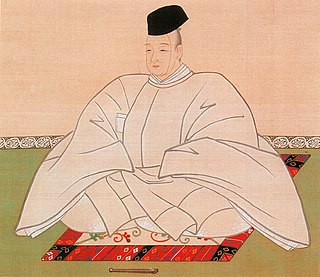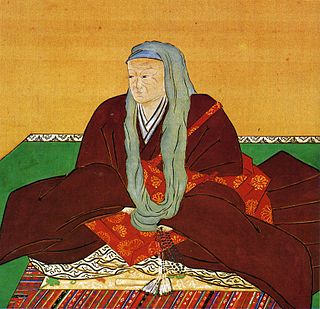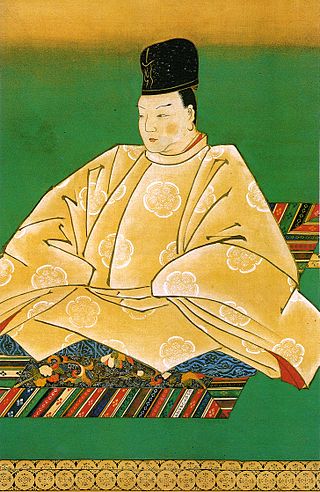Emperor Go-Reizei was the 70th emperor of Japan, according to the traditional order of succession.

Morohito, posthumously honored as Emperor Kōkaku, was the 119th emperor of Japan, according to the traditional order of succession. Kōkaku reigned from 1779 until his abdication in 1817 in favor of his son, Emperor Ninkō. After his abdication, he ruled as Daijō Tennō also known as a Jōkō (上皇) until his death in 1840. The next emperor to abdicate was Akihito, 202 years later.

Teruhito, posthumously honored as Emperor Sakuramachi was the 115th emperor of Japan, according to the traditional order of succession. He was enthroned as Emperor in 1735, a reign that would last until 1747 with his abdication. As with previous Emperors during the Edo period, the Tokugawa shogunate had control over Japan.

Emperor Go-Sanjō was the 71st emperor of Japan, according to the traditional order of succession. His given name was Takahito (尊仁).

Emperor Sanjō was the 67th emperor of Japan, according to the traditional order of succession.

Tsugihito, posthumously honored as Emperor Go-Kōmyō, was the 110th emperor of Japan, according to the traditional order of succession.

Satohito, posthumously honored as Emperor Reigen was the 112th emperor of Japan, according to the traditional order of succession. Reigen's reign spanned the years from 1663 through 1687.

Yasuhito, posthumously honored as Emperor Nakamikado, was the 114th emperor of Japan, according to the traditional order of succession. He was enthroned as Emperor in 1709, a reign that would last until 1735 with his abdication.

Asahito, posthumously honored as Emperor Higashiyama, was the 113th emperor of Japan, according to the traditional order of succession. Higashiyama's reign spanned the years from 1687 through to his abdication in 1709 corresponding to the Genroku era of the Edo period. The previous hundred years of peace and seclusion in Japan had created relative economic stability. The arts flourished, including theater and architecture.

The Kyōhō Reforms were an array of economic and cultural policies introduced by the Tokugawa shogunate between 1722–1730 during the Edo period to improve its political and social status. These reforms were instigated by the eighth Tokugawa shōgun of Japan, Tokugawa Yoshimune, encompassing the first 20 years of his shogunate. The name Kyōhō Reforms, refers to the Kyōhō period.

Hōreki (宝暦), also known as Horyaku, was a Japanese era name after Kan'en and before Meiwa. The period spanned the years from October 1751 through June 1764. The reigning emperor and empress were Momozono-tennō (桃園天皇) and Go-Sakuramachi-tennō (後桜町天皇).

Genbun (元文) was a Japanese era name after Kyōhō and before Kanpō. This period spanned the years from April 1736 through February 1741. The reigning emperor was Sakuramachi-tennō (桜町天皇).

Kyōhō (享保), also pronounced Kyōho, was a Japanese era name after Shōtoku and before Genbun. This period spanned the years from July 1716 through April 1736. The reigning emperors were Nakamikado-tennō (中御門天皇) and Sakuramachi-tennō (桜町天皇).

Kanbun (寛文) was a Japanese era after Manji and before Enpō. This period spanned the years from April 1661 to September 1673. The reigning emperors were Go-Sai-tennō (後西天皇) and Reigen-tennō (霊元天皇).

Kan'ei (寛永) was a Japanese era name after Genna and before Shōhō. This period spanned the years from February 1624 through December 1644. The reigning emperors and single empress were Go-Mizunoo-tennō (後水尾天皇), Meishō-tennō (明正天皇) and Go-Kōmyō-tennō (後光明天皇).

Genna (元和) was a Japanese era name coming after Keichō and before Kan'ei. This period spanned the years from July 1615 to February 1624. The reigning emperor was Go-Mizunoo-tennō (後水尾天皇). It is also known as Genwa.

Keichō (慶長) was a Japanese era name after Bunroku and before Genna. This period spanned from October 1596 to July 1615. The reigning emperors were Go-Yōzei-tennō (後陽成天皇) and Go-Mizunoo-tennō (後水尾天皇).

Chōroku (長禄) was a Japanese era name after Kōshō and before Kanshō. This period spanned the years from September 1457 through December 1460. The reigning emperor was Go-Hanazono-tennō (後花園天皇).

Jōkyō (貞享) was a Japanese era name after Tenna and before Genroku. This period spanned the years from February 1684 through September 1688. The reigning emperors were Reigen-tennō (霊元天皇) and Higashiyama-tennō (東山天皇).

Wadō (和銅) was a Japanese era name after Keiun and before Reiki. This period spanned the years from January 708 through September 715. The reigning monarch was Empress Genmei.











